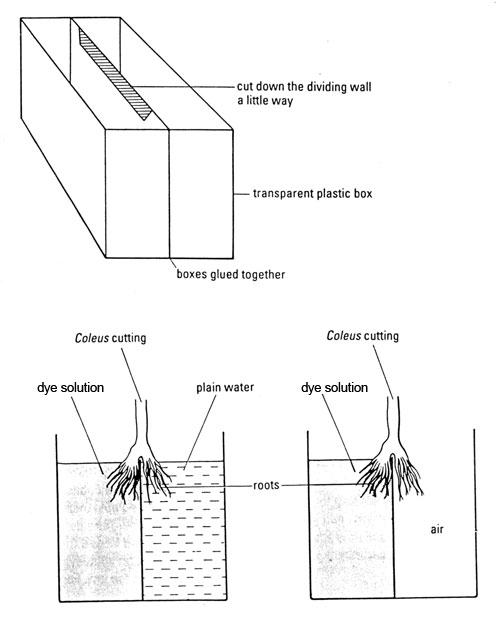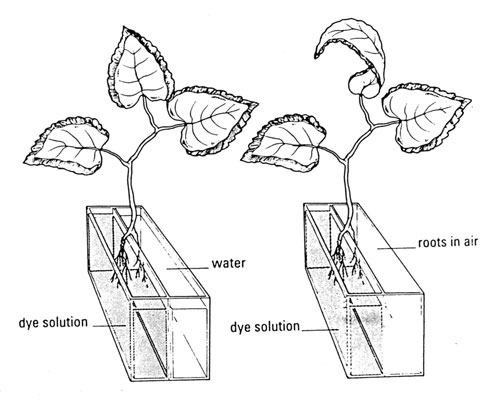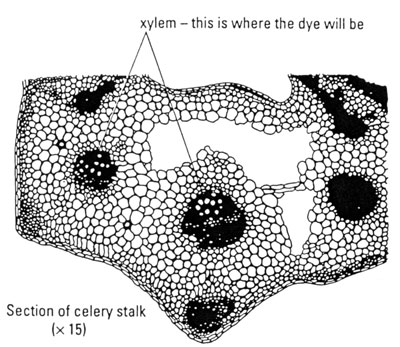Observing water moving through plants
Class practical
Observing plants in different situations allows students to make inferences about water movement through the plant material.
Lesson organisation
This could be set up as a circus of observations – depending how many of the plant setups you choose to use. Or you could run the ‘dye in stems’ section as a class practical, with the ‘plant in polythene bag’ and/ or the ‘cuttings in dye and water’ as demonstration practicals.
Apparatus and Chemicals
For each group of students:
Access to microscope
Microscope slides and coverslips
Dropping pipette and water
White tile or dissection board
Scalpel or sharp cutting tool
Hand lens
For the class – set up by technician/ teacher:
Coleus cuttings, with roots partly in dye and partly in water or air (needs 2-3 weeks advance preparation, Note 1)
Plant in pot, covered in polythene bag – set up an hour or two before lesson
Celery stalks or Busy Lizzie (Impatiens) stems in dye (Note 3)
Health & Safety and Technical notes
Take care with sharp scalpels.
Make a risk assessment of the chosen dye.
1 Coleus cuttings: Strike cuttings from Coleus two or three weeks in advance – using hormone rooting powder to encourage root formation and to reduce chance of infection of plants with fungus. Include liquid fertiliser in the water to encourage healthy growth. Coleus with lemon-coloured leaves are best as any dye will show up well in their tissues.
Two hours before the lesson, place some cuttings with part of their new root system in dye (Note 2) and the other part in water. Support another set of cuttings with part of their root system in dye and the other part in air. Rub off any stray roots so that all the roots are in a solution (for the water/ dye example). Plastic boxes used to hold indicator papers are ideal for this set-up. Stick two pairs of boxes together and cut a little way down the dividing wall. See diagram below.

2 Suitable dyes are dilute (0.1%) methylene blue solution, a blue food dye, 0.5% eosin or ink. Details of stains are on Hazcard 32. Methylene blue is described as harmful by skin contact whereas eosin is described as irritant. In either case, avoid skin contact.
3 Make a note of the time when you place the stems in dye. Ideally some samples should be set up at 24, 12, 2 and one hours before use. Alternatively, If celery stems are left to wilt and then placed in dye during the lesson, dye will move up the stem and into the leaves over a few minutes.
4 Celery can be difficult to cut neatly into sections, whereas Busy Lizzie is easy to slice thinly. The thickness is not critical – aim for about 1 mm and part of the section is likely to be thin enough. Make a small pool of water at the cut end and the slices will float.
Procedure
SAFETY: Take care with sharp scalpels.
Avoid skin contact with some dyes.
Preparation
a Set up plants in advance. Put the plant in the polythene bag in a sunny place for an hour or so. Put the other stems in dye up to 24 hours ahead of the lesson as described in Notes 1 and 3.
b Cut thin sections of celery or Busy Lizzie (Note 4).
Investigation

c Observe the plant in the polythene bag. The inside of the bag will be cloudy as water evaporating from the leaves condenses on the inside of the bag.

d Observe the stem of celery or Busy Lizzie. Use a sharp blade to cut across the stem at 1 cm intervals starting at the top and working down. Each time, use a hand lens to examine the cut surface for signs of the dye.
e Work out how fast the dye travels up the stem.
f Use a paint brush to transfer a thin slice of celery or Busy Lizzie (Note 4) to a microscope slide. Add enough water to make a complete layer between the slide and coverslip. Examine with a microscope.
g Describe what is seen.
h Observe the Coleus cuttings and note which parts of the leaves the dye has reached.

Teaching notes
Water travels up tall plants at about the same speed as the lifts that carry people to the top of a tall office block.
Typically, a coppice of beech of around 400 trees will raise about 20 tonnes of water a day from the soil to the leaves, 20 metres or so above the ground.
Although the process of transpiration is well understood in terms of plant structures, capillary action in narrow tubes and the process of osmosis of water through plant cell membranes, there are still some questions about transpiration that remain unanswered. For example, why is so much water moved from roots to leaves and then out into the air? Is it to keep the plant cool, or to transport sufficient dissolved minerals? And how do the tallest plants raise water to their highest leaves?
There are several opportunities here to make clear the difference between a description of what we observe and an explanation of the events that have resulted in what we see.
For example, in the cutting with half its roots in water and half in dye solution, some leaves show dye in their veins while others do not. In the other cutting, with one set of roots left in air, the dye appears throughout the veins. This is a description of our observation.
This is explained if, normally, each set of tubes from the roots supplies a particular area of leaf with water. However, when the need arises (such as when there is no water at all around a particular root) water can be transferred from one tube to another and so get to all parts of the leaves. This is an explanation of the observation above.
This diagram shows the likely position of the dye in the stem.

Health & Safety checked, September 2009
Downloads
Download the student sheet ![]() Observing water moving through plants (0.9 MB) with questions and answers
Observing water moving through plants (0.9 MB) with questions and answers
Related practicals
Investigating transport systems in a flowering plant
Estimating rate of transpiration from a plant cutting
Measuring rate of water uptake by a plant shoot using a potometer


